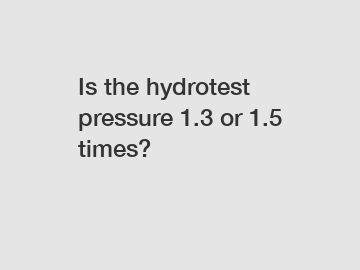Feb. 05, 2024
Tools
Is the hydrotest pressure 1.3 or 1.5 times?
When it comes to hydrostatic testing, a common question that arises is whether the test pressure should be 1.3 times or 1.5 times the design pressure. This topic has been a subject of debate and confusion among engineers and industry professionals. Let's take a closer look at this issue and hopefully clarify any doubts or uncertainties surrounding it.
Understanding Hydrostatic Testing.

Before diving into the debate, it is crucial to define what hydrostatic testing is and why it is essential. Hydrostatic testing is a non-destructive test performed on pressure vessels and pipelines to ensure their strength and integrity. It involves filling the vessel or pipe with a liquid, usually water, and pressurizing it to a predetermined pressure level.
The purpose of hydrostatic testing is to verify that a pressure vessel or pipeline can safely withstand its intended operating conditions. This test helps detect any leaks, defects, or weaknesses in the equipment, making it an indispensable inspection process in industries such as oil and gas, chemical, and manufacturing.
The Debate: 1.3 Times or 1.5 Times?
The debate over whether the hydrotest pressure should be 1.3 times or 1.5 times the design pressure centers around safety concerns and industry standards. Some argue that testing to 1.3 times the design pressure is sufficient and offers an acceptable safety margin. Others advocate for testing to 1.5 times the design pressure, stating that it provides a more conservative approach and ensures a higher level of safety.
Industry Standards and Codes.
To shed light on this matter, let's refer to some widely recognized industry standards and codes. The American Society of Mechanical Engineers (ASME) Boiler and Pressure Vessel Code, for instance, specifies that pressure vessels should be hydrostatically tested to 1.3 times the design pressure. This code is widely used and respected in the industry. However, some specific applications may require the hydrotest pressure to be 1.5 times the design pressure, as dictated by project specifications or regulatory requirements.
Factors to Consider.
When determining whether to test to 1.3 times or 1.5 times the design pressure, several factors need to be considered. These factors include the intended usage and safety requirements of the equipment, the specific industry or sector, and any applicable rules or regulations. Additionally, factors such as the potential consequences of failure, the history of similar equipment failures, and risk assessments play a role in the decision-making process.
Conclusion.
In conclusion, the debate over whether the hydrotest pressure should be 1.3 times or 1.5 times the design pressure does not have a one-size-fits-all answer. The decision ultimately relies on a careful evaluation of various factors, including industry standards, project specifications, and safety requirements. Consulting with industry experts and adhering to any applicable codes or regulations is essential to ensure the correct hydrotest pressure is determined.
If you have any further questions or require assistance regarding hydrostatic testing or any other engineering concerns, feel free to contact us. Our team of experts is here to provide guidance and support based on your unique needs.
The company is the world’s best oil-free nitrogen and air boosters, air compressor booster, freon pump supplier. We are your one-stop shop for all needs. Our staff are highly-specialized and will help you find the product you need.
If you are interested in sending in a Guest Blogger Submission,welcome to write for us!
All Comments ( 0 )